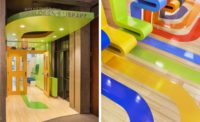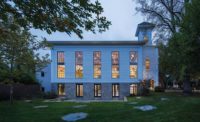W.PA/Works Partnership Architecture
An Oregon practice thrives by devising design-driven schemes that meet the needs of its developer clients.














Portland, Oregon
William Neburka describes the founding of W.PA/Works Partnership Architecture, the firm he and Carrie Strickland started five years ago, as “kind of a shotgun marriage. Carrie and I didn’t really know each other when we started the office.” But a developer with a big project in his back pocket had been encouraging Strickland to start her own office so she could take it on, and when she expressed reluctance to go it alone, he introduced her to Neburka. The two aspiring firm owners got together over drinks to discuss the possibility of working together. Strickland adds that their first meeting was “totally like a first date,” with the two of them agreeing on two things, at least: They both wanted to start firms, and the firms they started would most assuredly be design-oriented. “The project was too enticing to pass up,” Neburka continues, and with a large project in hand, they set up shop.
To date the firm’s clientele have been developers in the commercial office and multi- and single-family housing markets. Taking advantage of the fact that Portland has intense competition for office tenants, meaning that developers must use design as a way to attract them, the duo have turned out bSIDE6 (opposite), their first ground-up building, along with the 172,000-square-foot Olympic Mills Commerce Center and several housing projects. To attract housing developers, they have invented manufacturing systems that allow some elements of these buildings to be economically prefabricated.
Developers are pragmatists at heart, far more interested in the bottom line than, say, the niceties of cornice detailing. Yet Strickland and Neburka agree that one key to their success in subtly pushing a design agenda is to use a rational approach to show how good design will help make projects more successful. “People were willing to take a chance on us even though we were new because we never sat down and said, ‘Oh, here is a conceptual idea. Isn’t it cool?’ ” says Strickland. “We were talking about building design in a way that they could understand it, even if the conversation we were having on our own was a little different.” Neburka adds, “We’re comfortable looking at things very, very objectively. Once you can evaluate ideas and criteria that way, versus ‘We like this so you should like it, and you shouldn’t like this,’ then it really gets down to how functional design is going to improve their prospects for surviving economically and making money. We find that they care about the same things we do, but for different reasons.”
They also agree that being in the City of Roses, whose population is only 580,000, helped too. Neburka says, “You feel like you’re part of the conversation as opposed to just witnessing the conversation. There is nobody you can’t get on the phone, and there’s no construction issue that we can’t solve by talking to someone. Elsewhere, people come to the office with preconceived notions of what they want. The first meeting is where they bring the magazines out. In five years no one has brought a magazine in here and said, ‘This is what we want.’ Here, people are more open to you.”
We might not expect a “shotgun marriage” to be a success, but Neburka says, “Our interests and our abilities are so complementary — it’s serendipity, I guess.” It is a good thing. Olympic Mills, the project the pair went into business to get, went on hold almost immediately after they opened their doors. The project came back eventually, but many young firms wouldn’t have survived the crash business-development effort that saved their fledgling business.
W.PA/Works Partnership Architecture
LOCATION: Portland, Oregon
FOUNDED: 2005
DESIGN STAFF: 10
PRINCIPALS: William Neburka, Carrie Strickland
EDUCATION: Neburka — Syracuse University, B.A., 1997. Strickland — University of Cincinnati, B.A., 1999
WORK HISTORY: Neburka — Opsis Architecture, 2003–05; Potestio Architect, 2002; Strand/Neburka.Architects, 1999–2002; Kiss + Zwigard Architects, 1996–99; Koetter Kim & Associates, 1989–91. Strickland — DiLoreto Architects, 2002–05; Hub and Weber Architecture, 2000–02; GBBN Architects, 1998–2000; Sienna Architecture Company, 1996–97; Pieper O’Brien Herr Architects, 1994
KEY COMPLETED PROJECTS: Prototype A Tract House, Ridgefield, Wash., 2010; Bunk Bar, Portland, Ore., 2010; tandemDUO, Portland, Ore., 2010; bSIDE6, Portland, Ore., 2009; Milepost5 Artist Housing, Portland, Ore., 2008; Olympic Mills Commerce Center, Portland, Ore., 2007; 3808 Williams – The Hub, Portland, Ore., 2006
KEY CURRENT PROJECTS: Convention Plaza, Portland, Ore., 2011; grow.PDX, Portland, Ore., 2011; Theatre 300b, Portland, Ore., 2012; Workforce Housing, Portland, Ore., 2012
WEB SITE: www.worksarchitecture.net










